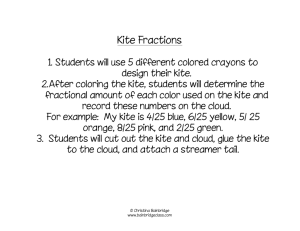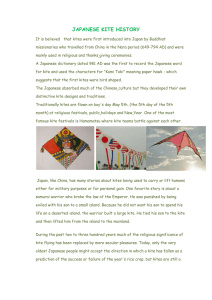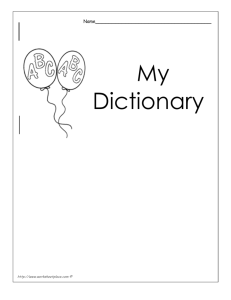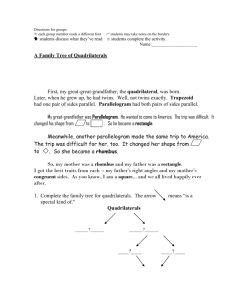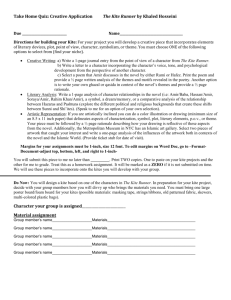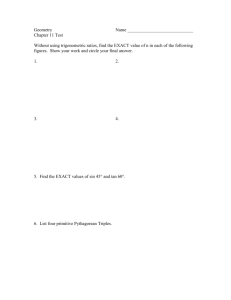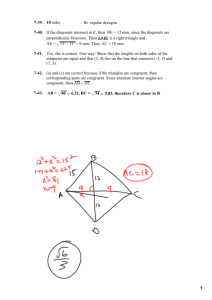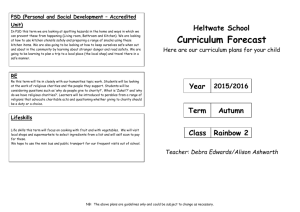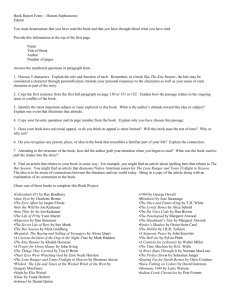Go Fly a Kite
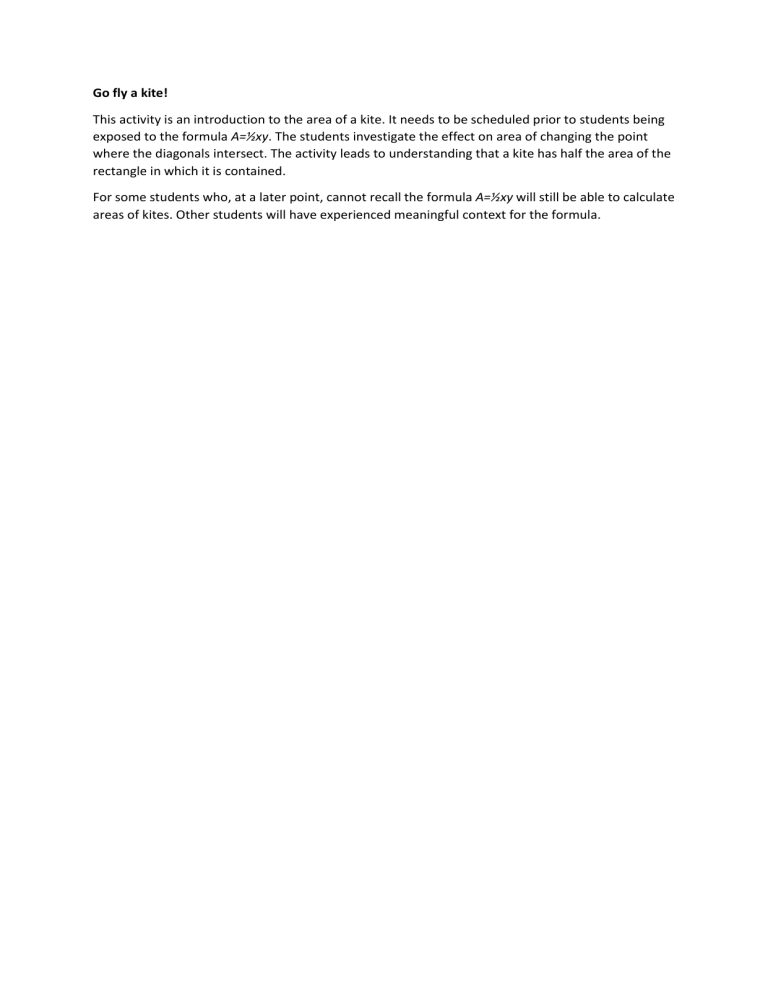
Go fly a kite!
This activity is an introduction to the area of a kite. It needs to be scheduled prior to students being exposed to the formula A=½xy. The students investigate the effect on area of changing the point where the diagonals intersect. The activity leads to understanding that a kite has half the area of the rectangle in which it is contained.
For some students who, at a later point, cannot recall the formula A=½xy will still be able to calculate areas of kites. Other students will have experienced meaningful context for the formula.
Mathematical focus
The area of kites
MA4-113MG A student uses formulas to calculate the areas of quadrilaterals and circles, and converts between units of area
Find areas of trapeziums, rhombuses and kites (ACMMG196)
MA4-1WM A student communicates and connects mathematical ideas using appropriate terminology, diagrams and symbols
MA4-2WM A student applies appropriate mathematical techniques to solve problems
MA4-3WM A student recognises and explains mathematical relationships using reasoning
Incidental connected content in context:-
Measuring length
Converting between units of length
Use of mathematical language- kite, dimensions, diagonals, sides, length, area, vertex and vertices
Groundwork
Students will need space to unfold and spread out a broadsheet newspaper page. Classroom desks may be appropriate but will need to be cleared. Students may be able to work on the floor or outside.
Pages from a broadsheet newspaper will be required. We will refer to The Australian newspaper, as it is a readily available broadsheet newspaper.
The narrative for the activity involves making kites from paper and dowel. The paper kite sails are cut from newspaper, but it is not necessary to actually make the frame from dowel.
Timing 90-120 minutes
The Task 1
The narrative is intended to engage the students with a problem to solve. While presented as a script, teachers can personalise it to help it sound natural.
Narrative 1
In cleaning up the storeroom I discovered some 1.5 m lengths of dowel and old copies of The
Australian newspaper. I decided that we would put them to use. You are going to design a kite.
What information do you need to know? What questions do you have?
Student pairs or small groups can discuss the questions briefly prior to a facilitated class discussion.
Some foreseeable questions are listed. The questions can be recorded and displayed. It may be necessary to revisit this step of generating questions after the students have started their investigation, particularly if few questions were originally generated: o What are the dimensions of pieces of the Australian newspaper pages? o How do we join the dowel to make the kite supports? o Where do we join the two pieces of dowel? o How do we attach the paper to the dowel? o Are the pieces of dowel long enough to make the kite? If so, will there be off cuts?
Establish that the pages of the Australian newspaper, once unfolded, are approximately 57.4cm by
82.6cm.
Kites have a related but different definition in mathematics to everyday usage. Provide students with this mathematical definition
A kite is “a quadrilateral with two pairs of adjacent sides of equal length” (Mathematics K-10 NSW
Syllabus for the Australian Curriculum, BOSTES)
Stage 4 students need to consider what this definition means. The time taken to do this may vary considerably depending on your class. Allow time for discussion in pairs then facilitate a short discussion without drawing a diagram.
Questions
What does this mean? Can you draw a kite and label the sides with markings to indicate equal side lengths?
Adjustments:
1
2
Isometric or grid paper may be used to scaffold the process for some students
Ask students to draw two equal adjacent sides. They have completed one vertex and have 2 incomplete vertices. Have them point to the three vertices. Ask where the fourth vertex would have to be to complete the kite so that the remaining two sides are equal.
The Task 2
Have students discuss these questions.
Narrative 2
To best catch the air when flying our kites, we want to maximise the area. We can alter the position where the 2 pieces of dowel join. How does the position of the intersection of the 2 pieces of dowel change the area? Where is the best place to make join the dowel?
Distribute pages from the newspaper.
Students, through folding the corners, decide on the shape of the kite that they think gives them the maximum area. Grouping the students in twos or threes will allow all students to participate, discuss, reason and collaborate.
Students experiments with varying the length marked “?”. How does this length seem to vary the
area? This is the essential question for the investigation.
This interactive allows the dot to be dragged to move the horizontal diagonal.
?
Insert http://tube.geogebra.org/m/erOwGYt2
Students cut triangles from the rectangle vertices to make a kite.
Groups are given the opportunity to compare their kite with others.
Which kite looks the biggest? How can you tell?
Students have the opportunity to solve these questions. The level of teacher intervention necessary for each group will vary greatly. It is important to allow students time to think through the problem and support student ownership of the learning.
The students may discover the two larger triangles, coloured blue in the diagram below, can be cut and positioned to form a rectangle whose area can be readily calculated.
This interactive displays the steps in cutting and moving the large triangles to form a rectangle.
Insert file http://tube.geogebra.org/m/1397115
Similarly the smaller triangles make a second rectangle.
The area of kite is then the area of the newspaper page minus the sum of the two rectangles.
The different groups of students can then compare their kite areas which should be equal. The variations in their answers can be discussed in terms of the limitations of measurement process and the inaccuracy of cuts. There will be a number of total areas that are very close to 2370cm 2 .
The teacher may collate the data to support the discussion. The data collected by students can be collated in a table.
Discuss with the students if it is fair to assume that all the areas would be the same if the measuring and cutting were more accurate. It may be valuable for some groups to check the calculations of others.
Ask the students for the difficulties they had in being accurate.
Students may notice that the cut triangles can be placed onto the kite, covering it completely without overlap. They may even realise that this means the kite has half the area of the original rectangle. We can assume that many won’t discover this for themselves without some prompting.
Prompts
Is there a relationship between the kite area and the original page? Can you make a hypothesis about this relationship is? How can you test your hypothesis?
If necessary, encourage student groups to lie their triangles on the kite and to try and cover it.
Reflection
It is important that students have ownership, individually or as part of a small team, of the discoveries that have been made:
1
2 that the position of the intersection of diagonals does not affect the area of a kite that the area of the kite is half the area of the rectangle that contains it
The conclusion to the activity is important in ensuring the students connect the activity with the mathematical content. Summarise the findings that the students made.
Ask the students to come up with a formula for the area of a kite. Use the original rectangle to scaffold their thinking.
Options
1.
The use of large pieces of paper such as pages from The Australian provides context and variety.
Essentially any sized paper rectangles can be used for the activity. Smaller pieces of paper are easier to fold and cut. Teachers may choose to use the narrative of the newspaper and dowel to introduce the investigation, but have students use A4 sheets of paper for the investigation.
2.
As the kite can be viewed as being composed of four right angled triangles, congruent triangle properties can be used to extend the activity to determine the geometrical properties of kites:-
Two pairs of equal adjacent sides
One pair of opposite equal angles
One axis of symmetry
One diagonal bisects the other
Diagonals intersect at right angles
The quadrilateral content is found in the Stage 4 sub-strand Properties of Geometrical Figures 1 while the congruent triangle properties are found in Properties of Geometrical Figures 2. A carefully planned scope and sequence allows for rich connections to be made across sub-strands.
